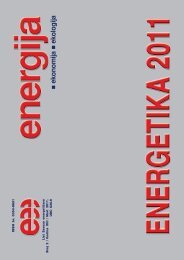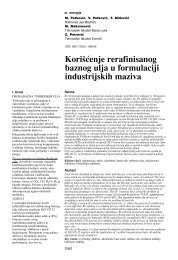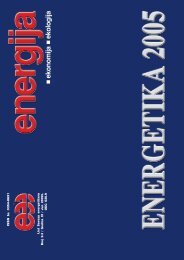ekonomija
2009-5
2009-5
- No tags were found...
Create successful ePaper yourself
Turn your PDF publications into a flip-book with our unique Google optimized e-Paper software.
energijamaterial to another, and even it is notclearly understood for some recentlydeveloped and used solar cell technologies!Theoretical calculations andexperimental laboratory results havepredicted the maximal solar cell efficiencyover 40%, however the practicalmarket production of such cells canbe delayed for decades, [1], mainly becauseof their expensive and complextechnology, lack in understanding ofphysical processes involved during thePV conversion in those complex cellsand ohmic and other parasitic losses inthe overall solar module devices.A PV technology is appealing from anenvironmental point of view becauseits impact on the environment isminimal, does not produce harmfulby-products, enables direct conversionof solar energy to electricity, there areno high temperatures involved thuscooling water devices are not required,PV technology is modular and portablein size, easy to assemble, soundlessbecause does not need any bulkymechanical generators for the energyconversion and it is a very flexiblepower generator - ranging from mWto MW.3. PV Cells and SystemsTechnologiesThe main task in PV solar cell developmentis to increase PV conversionefficiency and therefore to reduce solarcell cost. Nowadays, the silicon solarsells occupy the main share of the PVmarket. Monocrystalline and polycrystalline(multicrystalline) solar cells arethe leading market products. However,the huge investments and high costsare mainly the lack of silicon productiontechnology. PV semiconductorresearch and industry have been veryintensive in the last decade, bringingmore and more new conceptsand trends every year for solar celldevelopment and further improvementsin established PV technologies.A lot of research efforts have beengoing into the search for new materials.The leading idea is to replace Siand SiO2 (Si has very high meltingtemperature, over 1400 0 C, SiO2 about1800 0 C, therefore a huge amount ofenergy is required during the PV cellsfabrication procedures) with alloys andcompounds of materials with low-temperaturemelting points (such as Ga,Cd, In, Sb, etc.). This idea has madethe breakthrough of thin-film technologies(such as a-Si, GaAs, CIS, CIGS,CdTe, and so on). The new conceptsand new trends, involving new principlesof photon conversion process ornew classes of materials, are: thin-filmtandem cells, organic solar cells, polymersemiconductor solar cell, dye-sensitizedsolar cells, flexible solar cellsand other new conception solar cells.Some of those technologies, [8-19], arebriefly highlighted below.In an effort to save on materials andprocessing cost, a few manufacturershave turned to less pure silicon. Unlikethe nine 9s (99.9999999%) or eventhe eleven 9s (99.999999999%) ofpurity that is the result of the conventionalSiemens process used in silicongrowth, solar modules that are manufacturedusing Upgraded MetallurgicalGrade silicon (UMG) technology areof less purity, with a small effect onconversion efficiency, but significantcost reduction.Mono Crystalline (Single crystal)Silicon solar cellsMono crystalline or single crystallinecells are produced primarily by theCzochralski (Cz) process. The large diametersingle crystal silicon ingots thatare created from this process are cutinto thin wafers using thin wire saws.Solar panels that utilize single crystallinecells still dominates and offeramong the highest efficiencies availableon today’s market, however, about50% of the cost of the module is dueto the cost of processed silicon waferswith high purity. The cost reduction isdirectly related with reducing the siliconcontent of the module, e.g. by useof thinner wafers (0.2 mm thickness isreached today). The best laboratory efficienciesfor mono crystalline siliconsolar cells is 25%, and for productionsolar cell modules 15 to 17%.Poly Crystalline (Multi crystal)Silicon solar cellsCells that are created from polycrystallineor (multi crystalline) technologyare cut from a silicon boule that hasbeen casted from molten silicon andallowed to cool. The multi crystallinecell is grown from these silicon materialforms multifaceted crystals thatgrow in different directions. Conventionalmulti crystalline solar cells typicallyoffer a slightly lower efficiency.Ribbon Silicon solar cellsA process which cost less than traditionalmanufacturing techniques(using costly silicon sawing process) isknown as “Ribbon Growth”. Silicon isformed directly into thin wafers whichavoid the expensive process of sawingsilicon from a solid silicon boule. Solarpanels that that use this technologyare effective at saving material but[061]the quality of the material producedis not as high as the Czochralski (Cz)process. Cell efficiency is reduced,about 15%.Amorphous Silicon solar cells (thinfilm solar cells)Unlike crystalline silicon whose atomsare arranged in a very orderly fashion,the atoms in amorphous or thin filmsolar panels are not arranged in anyspecific pattern and in fact containmany structural and bonding defects.Amorphous solar panels are made byutilizing a vapour deposition processnot unlike spraying the silicon whichdeposits a microscopic thin layer ofdoped silicon onto a glass substrate.Although thin film is less costly tomanufacture than mono or poly crystallinetechnology they do suffer fromseveral drawbacks, among them is amuch lower efficiency. While monoand poly crystalline solar technologiestypically produce power in the 12 to15 percent efficiency range, thin filmtechnology’s efficiency range from 6to 9 percent. Another drawback withamorphous technology is an anomalyknown as the Staebler-Wronski effectwhereby the conversion efficiencyof amorphous solar panels has thetendency to degrade causing a dropin output of up to 20% when it is firstexposed to sunlight.CdTe solar technology (CadmiumTelluride thin film)Like their crystalline silicon thin filmcousins, Cadmium Telluride CdTesolar suffers from the same stigma oflower efficiency. The primary differencebetween both crystalline siliconand amorphous silicon when comparedto CdTe is that CdTe does not utilizesilicon in its design. Instead CdTesolar panels use a compound which isformed by a combination of Cadmiumand Tellurium blended with Zinc.Another difference between CdTe andmore traditional solar module technologiesis that Cadmium is an extremelytoxic material with known cancercausing effects, which raises concernsamong health officials, although CdTemodules have been touted as beingsafe especially once encapsulated in amodule. There is a wide-spread beliefthat the price of PV will drop dramaticallyover the next decade because ofthin-film CdTe production. The FirstSolar, the world’s leading producerof thin-film PV, reported recently thatthey have reduced the “direct manufacturingcost” to under $1/W P(“p” - peakpower) for the bare panels. However,one of the lowest cost installationsrecently completed costs about $4.3/















